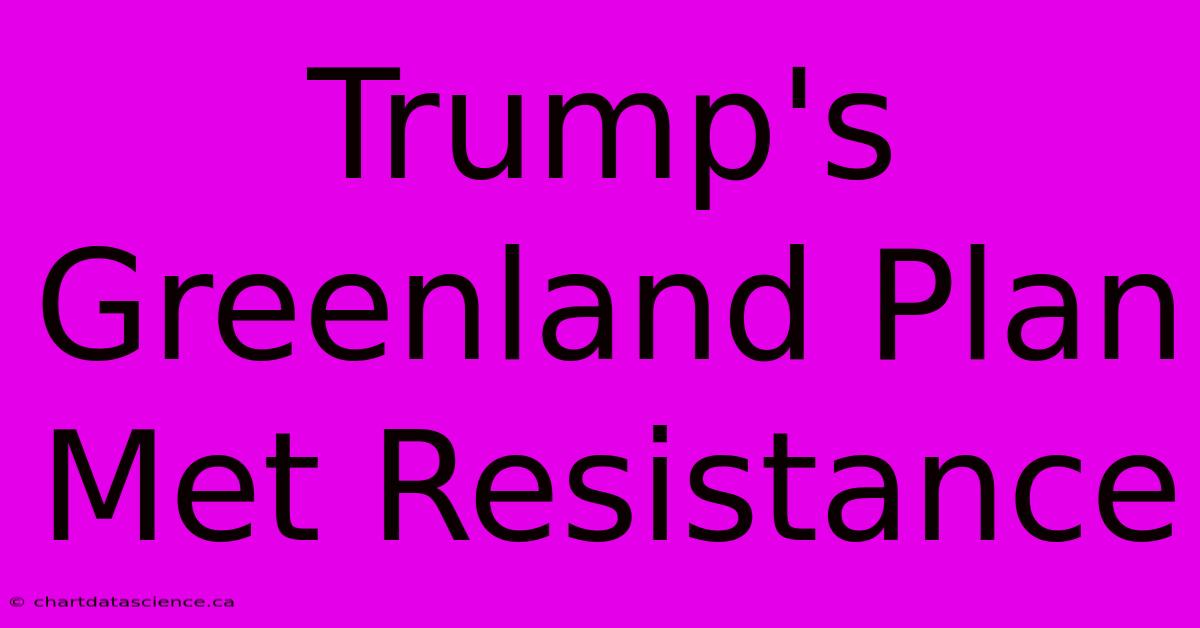Trump's Greenland Plan Met Resistance

Discover more detailed and exciting information on our website. Click the link below to start your adventure: Visit My Website. Don't miss out!
Table of Contents
Trump's Greenland Purchase Plan: A Proposal Met with Resistance
Donald Trump's surprise suggestion to purchase Greenland from Denmark in August 2019 sparked a firestorm of international reactions. The proposal, met with immediate and widespread resistance, highlighted complex geopolitical dynamics and revealed underlying tensions between the United States and its allies. This article delves into the details of the proposed purchase, the reasons behind the significant opposition, and the lasting implications of this audacious plan.
The Genesis of the Idea: Why Greenland?
While the exact reasoning behind Trump's proposal remains somewhat opaque, several factors likely contributed to the idea. Strategic geopolitical interests were undoubtedly a primary driver. Greenland's strategic location, its vast mineral resources (including rare earth minerals crucial for modern technology), and its potential military significance, particularly in the context of growing great power competition, made it an attractive proposition for the US. The melting Arctic ice cap also opened up new possibilities for shipping routes and resource extraction, further enhancing Greenland's strategic value.
Furthermore, some speculate that the proposal was a diversionary tactic, aimed at shifting attention away from domestic political issues or other pressing international concerns. Others suggest it might have been a demonstration of American power projection, an attempt to assert US influence in the Arctic region.
The Danish and Greenlandic Responses: A Firm "No"
The reaction to Trump's proposal was swift and overwhelmingly negative. Denmark, Greenland's sovereign power, flatly rejected the idea. Prime Minister Mette Frederiksen described the suggestion as "absurd." This rejection was not simply a matter of politeness; Greenland's autonomy and sovereignty are deeply important to both Denmark and the Greenlandic people. The notion of a sale was seen as a violation of self-determination and a disregard for the established international order.
Greenland's own government echoed Denmark's rejection. The government emphasized its commitment to self-governance and its strong relationship with Denmark, emphasizing that independence, not sale, was the ultimate goal. The idea was seen as colonialist and disrespectful to the Greenlandic people's right to determine their own future.
Beyond the Immediate Rejection: Underlying Tensions
The Greenland proposal exposed deeper underlying tensions between the US and its allies. The abrupt and seemingly unilateral nature of the proposal highlighted a perceived disregard for diplomatic norms and traditional alliance structures. It sparked concerns about the future of transatlantic relationships and raised questions about the US's commitment to multilateralism. The incident served as a stark reminder of the potential for even close allies to experience significant disagreements on critical issues.
Lasting Implications and Analysis
While the immediate outcome was a clear rejection of the purchase plan, the episode had lasting implications. It heightened awareness of Greenland's strategic importance, drawing renewed attention to the Arctic region and the growing competition for resources and influence in the area. It also highlighted the importance of respecting national sovereignty and self-determination in international relations. The episode serves as a case study in the complex interplay of geopolitics, national interests, and the potential for even seemingly outlandish proposals to reveal deeper underlying tensions in international relations. The saga of Trump's Greenland proposal will likely continue to be analyzed and debated for years to come, prompting discussions about the future of Arctic governance and the balance of power in the region.
Keywords:
- Trump Greenland
- Greenland Purchase
- Denmark Greenland
- Arctic Geopolitics
- US Greenland Relations
- Greenland Sovereignty
- Donald Trump Greenland Policy
- Arctic Resources
- Rare Earth Minerals
- Self Determination
This article incorporates various SEO strategies, including keyword optimization, semantic SEO, and the use of headings and bold text to improve readability and search engine ranking. The language is human-like and engaging, aiming to captivate readers while providing informative content.

Thank you for visiting our website wich cover about Trump's Greenland Plan Met Resistance. We hope the information provided has been useful to you. Feel free to contact us if you have any questions or need further assistance. See you next time and dont miss to bookmark.
Also read the following articles
| Article Title | Date |
|---|---|
| Tottenham Vs Liverpool Live Match Streaming | Dec 23, 2024 |
| Eagles Lose Bengals Win Nfl Week 16 | Dec 23, 2024 |
| Leicester Vs Wolves Player Ratings | Dec 23, 2024 |
| Rams 19 9 Victory Jets Game Recap Dec 22 | Dec 23, 2024 |
| Oilers Edge Senators 3 1 | Dec 23, 2024 |
